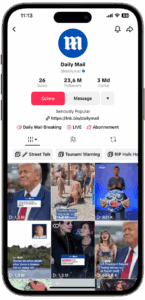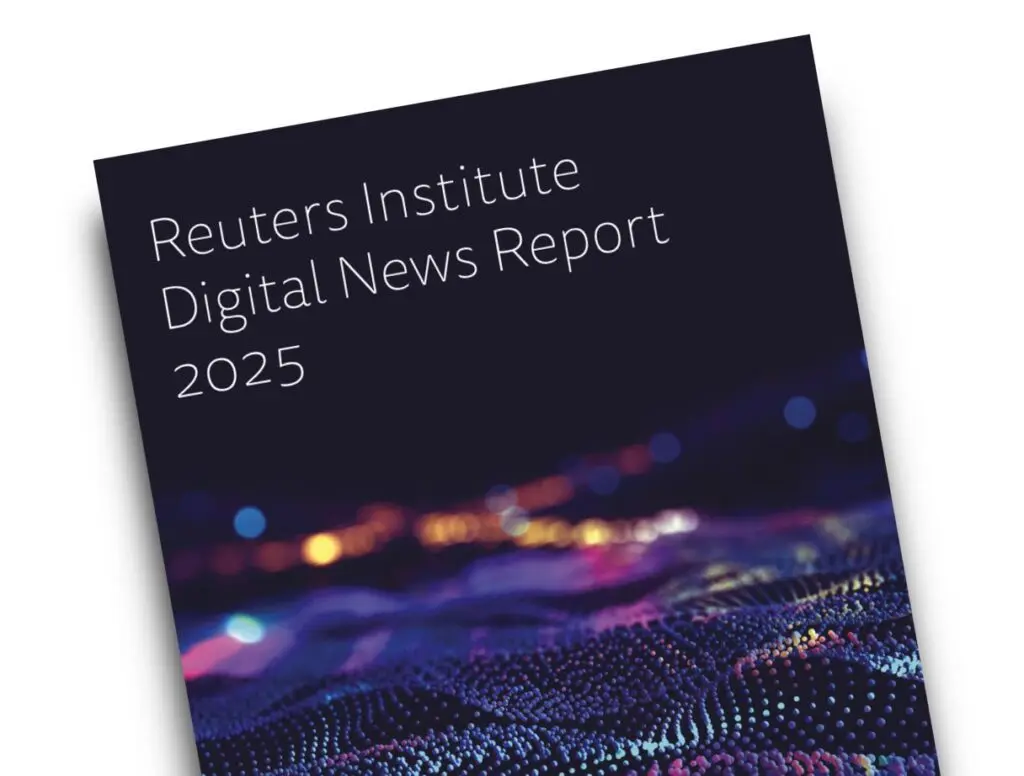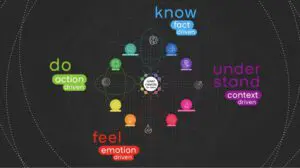The latest edition of the Reuters Institute’s Digital News Report confirms what we observe daily: news consumption habits are changing fast. From audience fragmentation and the rise of new influencers to the transformation of formats, the media ecosystem is undergoing a deep structural shift—rewriting the rules of the game for communication professionals.
These changes are not just challenges to navigate. They also represent opportunities for organisations that can decode these new dynamics and adapt their editorial strategies accordingly. Here are six key trends to watch.
1. The decline of traditional media: audience loss, but not (yet) trust
The figures speak for themselves: TV, print, and news websites are losing ground. In the US, social and video platforms have overtaken TV and news sites as the primary sources of news (54%, compared to 50% for TV and 48% for websites).
Yet trust in the media has held steady at 40%, suggesting that shrinking audiences reflect fragmented habits rather than outright distrust.
Your key stakeholders – even senior profiles – are now getting their news elsewhere: LinkedIn, newsletters, YouTube, podcasts… But their expectations for reliable and in-depth content remain unchanged.
The challenge is not to be everywhere, but to build strong editorial touchpoints on the channels that matter most to your audience.
2. Influencers and creators: a new media order
In France, Hugo Décrypte reaches 22% of under-35s. In the US, controversial podcaster Joe Rogan reaches a similar share. These hybrid figures – at the crossroads of journalism, opinion, and entertainment – are becoming major gateways to current events.
The paradox? They’re also seen as top sources of misinformation, alongside politicians (47%).
On most platforms except Facebook, creators now outperform traditional media. On TikTok, YouTube, Instagram and X, content from creators grabs more attention than content from established outlets. Traditional media still struggle to adapt to these direct, emotional, human-centred formats.
Yet TikTok, with 1.7 billion active users globally – 63% of whom are under 24 – is now an essential platform.
This shift opens up a strategic opportunity for businesses: embodiment builds credibility. Elevating internal voices, training executives in media codes, or producing human-centred editorial formats can all set a brand apart – as long as the message remains authentic, well-crafted, and well-edited.
The Editorialist can support you in shaping this voice: media training, opinion pieces, executive video formats, or editorial interviews.
Get in touch
Spotlight: the US and the Trump creator ecosystem
Donald Trump’s campaign strategy exemplifies the shift. While his 2016 bid was propelled by traditional media coverage, his 2024 run relied heavily on a network of digital creators – podcasters, YouTubers, influencers.
This reflects a generational shift: 54% of 18–24-year-olds and 50% of 25–34s now cite social and video platforms as their main news sources – up 13 and 6 points respectively in one year.
3. Video: the format of choice for younger audiences
In just five years, the share of people consuming news via video on social platforms has jumped from 52% to 65%. YouTube is now used by 30% of internet users for news, confirming its place as a standalone media platform. TikTok continues to grow fast, especially among under-25s (+4 points this year), with some countries seeing usage peak at 49% (e.g. Thailand).
In many Southern markets (India, Philippines, South Africa…), video has overtaken reading as the preferred way to access news. In the US, 72% of users watch news videos every week – and 61% do so via third-party platforms.

Video is no longer a “nice to have”, but the go-to format to inform and engage, particularly among under-35s. Short, human-led, educational formats—interviews, explainers, face-to-camera segments—perform especially well on LinkedIn, YouTube, and Instagram.Even TikTok is no longer just about entertainment: media outlets like The Daily Mail have pioneered informative content on the platform, now boasting 23M+ followers and over 3Md likes.
But success on TikTok requires thoughtful planning: define your message, format, tone and value. It’s not the right platform for every business or topic—but when used well, it offers a powerful way to inform differently.
Beyond TikTok, it’s time to (re)think your entire mobile-first video strategy: from LinkedIn carousels to YouTube Shorts. The Editorialist supports your full video journey – from concept to scripting, agile production, platform adaptation and distribution strategy.
4. Podcasts go premium
15% of Americans now listen to a news podcast every week—more than those who read print newspapers. This format resonates strongly with under-35s, degree-holders, and higher-income audiences.
73% of listeners say podcasts help them understand complex topics more effectively.
Podcasts offer a distinctive edge: the ability to develop in-depth analysis in an accessible format. For companies, they’re a strategic tool to tell stories of transformation (CSR, innovation, governance), shape a brand narrative, or promote internal culture.
They’re also highly valued by hard-to-reach audiences like decision-makers. In the US and UK, 43% of executives cite podcasts as their primary source of information.
Want to know how decision-makers consume content? Read our study: Where and How Do Decision-Makers Get Their Information?
5. The rise of premium subscriptions
While general audiences remain hesitant to pay for news, premium publishers are growing fast. In 2025, The Economist reached 1.25 million subscribers (+3%), with 85% of new subscriptions digital. The Financial Times crossed £500 million in revenue for the first time, powered by expert content and tailored editorial services (FT Specialist now has 430,000 paid subscribers).
Your stakeholders now expect more than just content. They seek:
- Strong viewpoints
- Useful, actionable formats
- Decision-making tools
- To meet those expectations, offer high-value editorial formats:
- Sector trend briefings
- Thematic summaries
- White papers
- Forward-looking analysis
- CIO Outlooks
These formats build brand preference and improve conversion among premium audiences.
Final takeaway: what audiences expect
The Reuters Institute asked the public what improvements they want from the media. Four clear expectations emerged:
- Impartiality: Audiences want journalism that serves facts—not self-interest.
- Accuracy: Avoid speculation, check the facts, and focus on the truth.
- Transparency: Clearly document sources, explain funding, distinguish opinion from fact, and visibly correct errors.
- Higher quality: Go beyond clickbait—investigate those in power, offer more depth, and recruit more expert journalists on the ground.
These expectations don’t only apply to media outlets. Companies, too, must rise to the challenge.
Your content must do more than inform—it must build trust. That means:
- Turning your commitments into clear, verifiable narratives
- Ensuring alignment between form and substance
- Demonstrating transparency in your processes
The Digital News Report 2025 confirms what we see daily at The Editorialist: Information is now a strategic asset for organisations. But only if you know your audience, stand by your values, and produce content that is useful by design.



